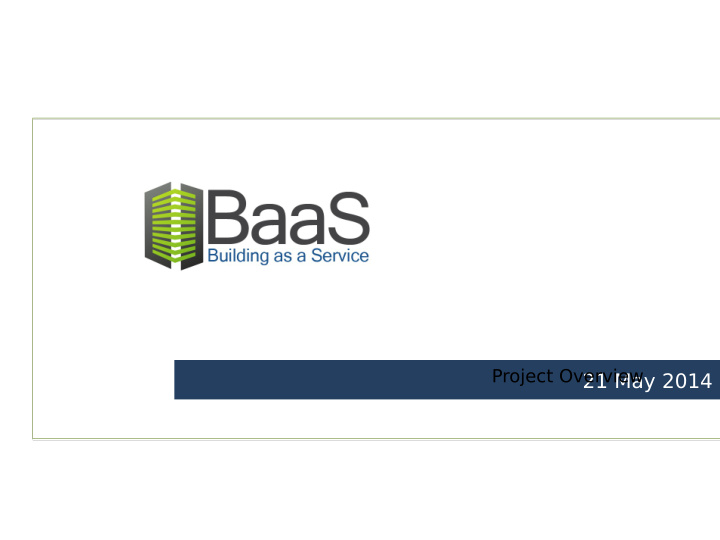



Project Overview 21 May 2014
Motivation – Evolution of Building Management Systems
Vision – Future Integrated Smart Buildings T oday’s commercial buildings • Wealth of difgerent, but isolated automation, management and information systems • Integration of the difgerent systems requires high engineering efgort Future integrated smart buildings • Integration of legacy and novel BAS with minimal engineering efgort • Convergence of BAS and ICT systems • Uniform Information Model and comprehensive Semantic Knowledge • Value-added building services on top of integrated BAS and ICT systems
BaaS Challenges Overcome traditional silo structures • no interoperability between BA domains • hindering comprehensive data analysis • no creation of knowledge Avoid proprietary engineering approach • not fmexible: high engineering efgort required • proprietary: lack of standardized interfaces • no quick creation of new applications Introduce common semantic model • system to be operated by experts only • no common information model and semantics • no easy integration of existing / legacy systems • no quick creation of new applications
BaaS Approach – Situation and Vision Situation : A building consists of difgerent systems with difgerent • Responsibilities: – Building automation: heating & ventilation, lighting & blinds, … – Facility management: room reservation, access control, … – IT management: network access, printing services, beamer control, … • Partly standardized data models: BACnet, KNX, oBix, OPC-UA, … • Proprietary engineering models: Siemens DESIGO, Kieback & Peter, ... • Communication interfaces: KNX, BACnet, EEBUS, CAN, WS + oBIX, ... • Degree of self-description: the integration of BIM + BAS + BAS-semantics is currently not existing Vision : Integrated building systems that are easily extensible in terms of new services and applications and are based on an open standardized semantic building services platform.
BaaS Approach – Problem and Mission Problem (what we sufger from) • Engineering, commissioning and operation of domains requires a host of difgerent tools (from difgerent vendors, for difgerent technologies) • The resulting system models, confjgurations and interfaces are mostly proprietary and often not available online or in the fjeld • Lack of common information models and integrated engineering tools makes it very hard to add additional services to an existing installation Mission (what we need to do) • Standardized communication mechanisms (a.k.a. transport bindings) • Domain independent data models and associated representations • Semantic models for services and data following common ontologies • T ools for integration of legacy systems, data models, and interfaces • T ools for developing and integrating new value-added services and applications (incl. engineering and commissioning support)
IoT Architecture Reference Model: Functional View
IoT ARM: Deployment Confjgurations
BaaS Reference Architecture (Functional sketch)
European Project Partners 21 May 2014
Project partners Model based management Planning phase Run time phase Abstraction layer at run time Hierarchical object model for management of relevant resources 9/1/14 Materna 11
Project partners Model based management Usability Event-condition-action OSGI remote services Legacy support 9/1/14 TU Dortmund 12
Project partners Real time capable web services Web services on embedded devices Real time web service 9/1/14 Universität Rostock 13
Project partners Domain specifjc languages Platform SDK Semantic web of things 9/1/14 Siemens 14
Project partners Smart city Smart lighting Light paths for humans Room booking User feedback, e.g. NFC 9/1/14 everis 15
Project partners Value added services based on geographic information Geolocated objects and services Indoor positioning Visual interaction with the building 9/1/14 prodevelop 16
Smart Meeting Room 21 May 2014
Smart meeting room The Smart Meeting Room orchestrates beyond silos: Lights Heating, Ventilation, AC Shutters and enables convergence with traditional IT: Network Computing devices 9/1/14 18
Reconfjguration triggered by… Presence detection utilizing a variety of sensors Passive infrared Ultrasonic Identifjcation RFID + External conditions Light T emperature Room planning and schedule 9/1/14 19
Reconfjguration T enant profjles and policies User feedback User corrects mistake, e.g. adjusts temperature Optimization and predictive automation Modularized reasoning over context 9/1/14 20
21 May 2014 Predictive Automation
Use-Case: Predictive Automation for Energy Effjcient Buildings Goal : develop mechanisms to reduce the energy consumption of shared spaces, while still complying with the needs of users Room Bookin User Historica g preference Example: proactive temperature control l data Syste s of a meeting room based on user-preferences, available devices, room m layout, outside temperature and historical data TWT Optimization Algorithms T echnical Approach: Semantic BaaS sensor fusion & information processing & domain-specifjc optimization framework algorithms control Shared Main BaaS features needed: Space Semantic abstraction from actual hardware BaaS – 21.05.2014 Andreas Müller – TWT GmbH 22
Recommend
More recommend